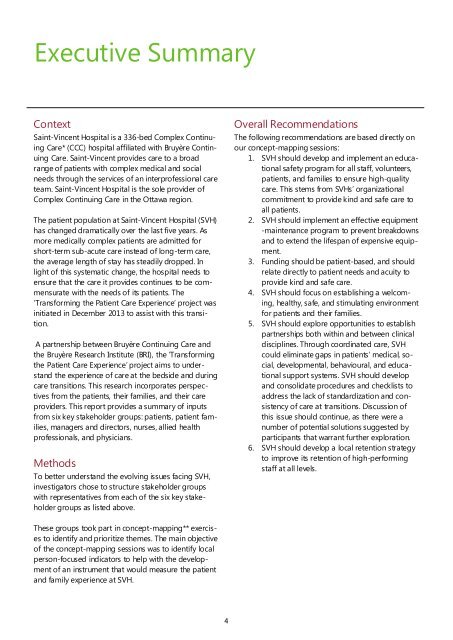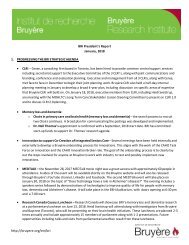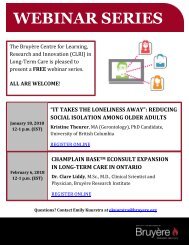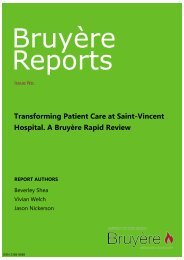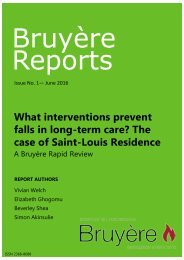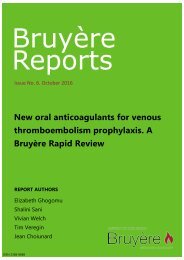Using Concept Mapping to Build Coordinated, Person-centered, High-quality Care at Saint-Vincent Hospital: Summary of Evidence
Create successful ePaper yourself
Turn your PDF publications into a flip-book with our unique Google optimized e-Paper software.
Executive <strong>Summary</strong><br />
Context<br />
<strong>Saint</strong>-<strong>Vincent</strong> <strong>Hospital</strong> is a 336-bed Complex Continuing<br />
<strong>Care</strong>* (CCC) hospital affili<strong>at</strong>ed with Bruyère Continuing<br />
<strong>Care</strong>. <strong>Saint</strong>-<strong>Vincent</strong> provides care <strong>to</strong> a broad<br />
range <strong>of</strong> p<strong>at</strong>ients with complex medical and social<br />
needs through the services <strong>of</strong> an interpr<strong>of</strong>essional care<br />
team. <strong>Saint</strong>-<strong>Vincent</strong> <strong>Hospital</strong> is the sole provider <strong>of</strong><br />
Complex Continuing <strong>Care</strong> in the Ottawa region.<br />
The p<strong>at</strong>ient popul<strong>at</strong>ion <strong>at</strong> <strong>Saint</strong>-<strong>Vincent</strong> <strong>Hospital</strong> (SVH)<br />
has changed dram<strong>at</strong>ically over the last five years. As<br />
more medically complex p<strong>at</strong>ients are admitted for<br />
short-term sub-acute care instead <strong>of</strong> long-term care,<br />
the average length <strong>of</strong> stay has steadily dropped. In<br />
light <strong>of</strong> this system<strong>at</strong>ic change, the hospital needs <strong>to</strong><br />
ensure th<strong>at</strong> the care it provides continues <strong>to</strong> be commensur<strong>at</strong>e<br />
with the needs <strong>of</strong> its p<strong>at</strong>ients. The<br />
‘Transforming the P<strong>at</strong>ient <strong>Care</strong> Experience’ project was<br />
initi<strong>at</strong>ed in December 2013 <strong>to</strong> assist with this transition.<br />
A partnership between Bruyère Continuing <strong>Care</strong> and<br />
the Bruyère Research Institute (BRI), the ‘Transforming<br />
the P<strong>at</strong>ient <strong>Care</strong> Experience’ project aims <strong>to</strong> understand<br />
the experience <strong>of</strong> care <strong>at</strong> the bedside and during<br />
care transitions. This research incorpor<strong>at</strong>es perspectives<br />
from the p<strong>at</strong>ients, their families, and their care<br />
providers. This report provides a summary <strong>of</strong> inputs<br />
from six key stakeholder groups: p<strong>at</strong>ients, p<strong>at</strong>ient families,<br />
managers and direc<strong>to</strong>rs, nurses, allied health<br />
pr<strong>of</strong>essionals, and physicians.<br />
Methods<br />
To better understand the evolving issues facing SVH,<br />
investiga<strong>to</strong>rs chose <strong>to</strong> structure stakeholder groups<br />
with represent<strong>at</strong>ives from each <strong>of</strong> the six key stakeholder<br />
groups as listed above.<br />
Overall Recommend<strong>at</strong>ions<br />
The following recommend<strong>at</strong>ions are based directly on<br />
our concept-mapping sessions:<br />
1. SVH should develop and implement an educ<strong>at</strong>ional<br />
safety program for all staff, volunteers,<br />
p<strong>at</strong>ients, and families <strong>to</strong> ensure high-<strong>quality</strong><br />
care. This stems from SVHs’ organiz<strong>at</strong>ional<br />
commitment <strong>to</strong> provide kind and safe care <strong>to</strong><br />
all p<strong>at</strong>ients.<br />
2. SVH should implement an effective equipment<br />
-maintenance program <strong>to</strong> prevent breakdowns<br />
and <strong>to</strong> extend the lifespan <strong>of</strong> expensive equipment.<br />
3. Funding should be p<strong>at</strong>ient-based, and should<br />
rel<strong>at</strong>e directly <strong>to</strong> p<strong>at</strong>ient needs and acuity <strong>to</strong><br />
provide kind and safe care.<br />
4. SVH should focus on establishing a welcoming,<br />
healthy, safe, and stimul<strong>at</strong>ing environment<br />
for p<strong>at</strong>ients and their families.<br />
5. SVH should explore opportunities <strong>to</strong> establish<br />
partnerships both within and between clinical<br />
disciplines. Through coordin<strong>at</strong>ed care, SVH<br />
could elimin<strong>at</strong>e gaps in p<strong>at</strong>ients’ medical, social,<br />
developmental, behavioural, and educ<strong>at</strong>ional<br />
support systems. SVH should develop<br />
and consolid<strong>at</strong>e procedures and checklists <strong>to</strong><br />
address the lack <strong>of</strong> standardiz<strong>at</strong>ion and consistency<br />
<strong>of</strong> care <strong>at</strong> transitions. Discussion <strong>of</strong><br />
this issue should continue, as there were a<br />
number <strong>of</strong> potential solutions suggested by<br />
participants th<strong>at</strong> warrant further explor<strong>at</strong>ion.<br />
6. SVH should develop a local retention str<strong>at</strong>egy<br />
<strong>to</strong> improve its retention <strong>of</strong> high-performing<br />
staff <strong>at</strong> all levels.<br />
These groups <strong>to</strong>ok part in concept-mapping** exercises<br />
<strong>to</strong> identify and prioritize themes. The main objective<br />
<strong>of</strong> the concept-mapping sessions was <strong>to</strong> identify local<br />
person-focused indica<strong>to</strong>rs <strong>to</strong> help with the development<br />
<strong>of</strong> an instrument th<strong>at</strong> would measure the p<strong>at</strong>ient<br />
and family experience <strong>at</strong> SVH.<br />
4


